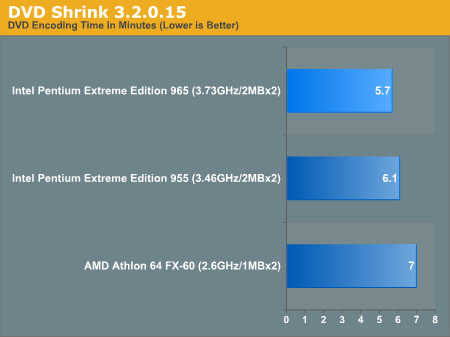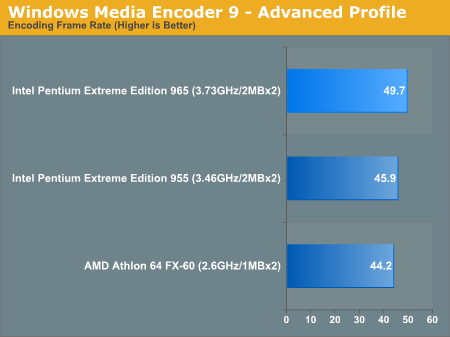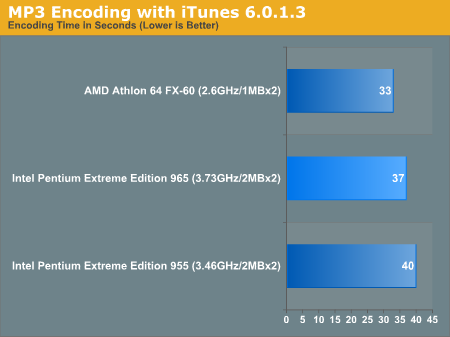Intel's Pentium Extreme Edition 965: The Last of a Dying Breed
by Anand Lal Shimpi on March 22, 2006 1:51 PM EST- Posted in
- CPUs
Media Encoding Performance using DVD Shrink, WME9, Quicktime and iTunes
First up is DVD Shrink 3.2.0.15. Our test was simple - we took a copy of Star Wars Episode VI and ripped the full DVD to the hard drive without compression, effectively giving us an exact copy of the disc on the hard drive. Then, using the copy of the DVD on the hard drive (to eliminate any DVD drive bottlenecks), we performed a DVD shrink operation to shrink the movie to fit on a single 4.5GB DVD disc. All of the options were left on their defaults, so the test ends up being pretty easy to run and reproduce. The scores reported are DVD encoding times in minutes, with lower numbers meaning better performance.
The DVD Shrink test is quite important as DVD Shrink is quite possibly one of the easiest tools to rip a DVD. The easier a tool is to use, the more likely that it's going to be used, and arguably the more important performance using it happens to be.
Moving on, we have our Windows Media Encoder 9 test, which uses the advanced profile settings for video encoding. We left all settings at their defaults and just proceeded with a MPEG-2 to WMV-HD conversion. The values reported are in frames per second, with higher numbers being better.
Next up, we have Quicktime Pro 7.0.3 and we perform a MPEG-2 to H.264 encoding task. We've changed our test a bit to make it more streamlined. The export settings are left on their Export to Quicktime Movie defaults (which happens to be a H.264 export). We simply changed the audio encoder to use Apple's AAC codec instead. We report the transcoding time in minutes, with lower values being better.
Finally, we have a MP3 encoding test using iTunes 6.0.1.3. For this test, we simply took a 304MB wav file and converted it to a 192kbps MP3 file, measuring the encode time in seconds. The only iTunes option that we changed was to prevent the playback of the song while encoding.
First up is DVD Shrink 3.2.0.15. Our test was simple - we took a copy of Star Wars Episode VI and ripped the full DVD to the hard drive without compression, effectively giving us an exact copy of the disc on the hard drive. Then, using the copy of the DVD on the hard drive (to eliminate any DVD drive bottlenecks), we performed a DVD shrink operation to shrink the movie to fit on a single 4.5GB DVD disc. All of the options were left on their defaults, so the test ends up being pretty easy to run and reproduce. The scores reported are DVD encoding times in minutes, with lower numbers meaning better performance.
The DVD Shrink test is quite important as DVD Shrink is quite possibly one of the easiest tools to rip a DVD. The easier a tool is to use, the more likely that it's going to be used, and arguably the more important performance using it happens to be.

Moving on, we have our Windows Media Encoder 9 test, which uses the advanced profile settings for video encoding. We left all settings at their defaults and just proceeded with a MPEG-2 to WMV-HD conversion. The values reported are in frames per second, with higher numbers being better.

Next up, we have Quicktime Pro 7.0.3 and we perform a MPEG-2 to H.264 encoding task. We've changed our test a bit to make it more streamlined. The export settings are left on their Export to Quicktime Movie defaults (which happens to be a H.264 export). We simply changed the audio encoder to use Apple's AAC codec instead. We report the transcoding time in minutes, with lower values being better.

Finally, we have a MP3 encoding test using iTunes 6.0.1.3. For this test, we simply took a 304MB wav file and converted it to a 192kbps MP3 file, measuring the encode time in seconds. The only iTunes option that we changed was to prevent the playback of the song while encoding.

3D Rendering Performance using 3dsmax 7
Gaming Performance using Battlefield 2, Call of Duty 2 and Quake 4










41 Comments
View All Comments
AnandThenMan - Thursday, March 23, 2006 - link
"Would you have preferred we not have this review at all?"What are you suggesting? That the review can't be published unless Conroe benches are in there as well? Let's be very clear here. Anandtech is publishing Intel sanctioned benches as the gospel truth. Anandtech is publishing benchmarks on an un-released product, running on unknown hardware, unknown settings, under restricted testing conditions, and passing them off without question at all.
If this is the way Anandtech plans to do all articles from now on, then I want to see benches that include future products from ATI, NVIDIA, and others as much as possible. And it won't matter if ATI or NVIDIA supplies the hardware, doesn't allow anyone to see it, and puts restrictions on what benches can be run and for how long. Anandtech will STILL publish these benches and assure us all they are 100% accurate.
It is very, very dissapointed to see Anandtech pull this crap. Conroe could very well live up the the hype and more. That is not the point. Integrity of testings means you control the testing environment, you control the hardware, and you control the software. And if you DON'T, then you SPECULATE and make it very clear that the results are speculation. You don't announce, "Intel takes back the performance crown" based on tests Intel let you perform. Very poor job.
AnnonymousCoward - Friday, March 24, 2006 - link
You're overreacting. Any reader knows that the original Conroe tests couldn't be 100% verified, since Anand made that very clear. So then you read this review, and you keep that in mind. Big whoop.Thanks, Anand, for showing the Conroe numbers. It's information that any sane builder would want to see, even though the numbers haven't been independently confirmed.
PrinceGaz - Thursday, March 23, 2006 - link
"If this is the way Anandtech plans to do all articles from now on, then I want to see benches that include future products from ATI, NVIDIA, and others as much as possible. And it won't matter if ATI or NVIDIA supplies the hardware, doesn't allow anyone to see it, and puts restrictions on what benches can be run and for how long. Anandtech will STILL publish these benches and assure us all they are 100% accurate."It would be a bit pointless for the companies to supply the hardware, but not allow anyone to see it and put restrictions on the benchmarks run. It would be far more sensible if the companies simply ran the benchmarks on future products themselves, and provided Anand with the figures to publish :)
Zebo - Wednesday, March 22, 2006 - link
Anand is doing intel's dirty work. It's called osborne effect - leak an upcoming products when you have nothing to undercut competitors sales. Brillaint move by intel - and Anand is being played like fiddle.Zebo - Wednesday, March 22, 2006 - link
How do you know there was'nt a 3.6 Ghz conroe in there?cornfedone - Wednesday, March 22, 2006 - link
SOS, DD.They ain't got a clue.
ksherman - Wednesday, March 22, 2006 - link
not sure if it is real or not, but it goes down in my bookas one sweet word: "obsolescence" (found in the closing paragraph)Chadder007 - Wednesday, March 22, 2006 - link
Who in their right mind would purchase this processor??? ....on yeah, the one that buys the new $10,000 Dell. :kekekeke:jojo4u - Wednesday, March 22, 2006 - link
EIST was introduced in the 6xx series and not in the 5xxJ as the article suggests.Anand Lal Shimpi - Wednesday, March 22, 2006 - link
You are correct, I've made the appropriate change to the article :)Take care,
Anand